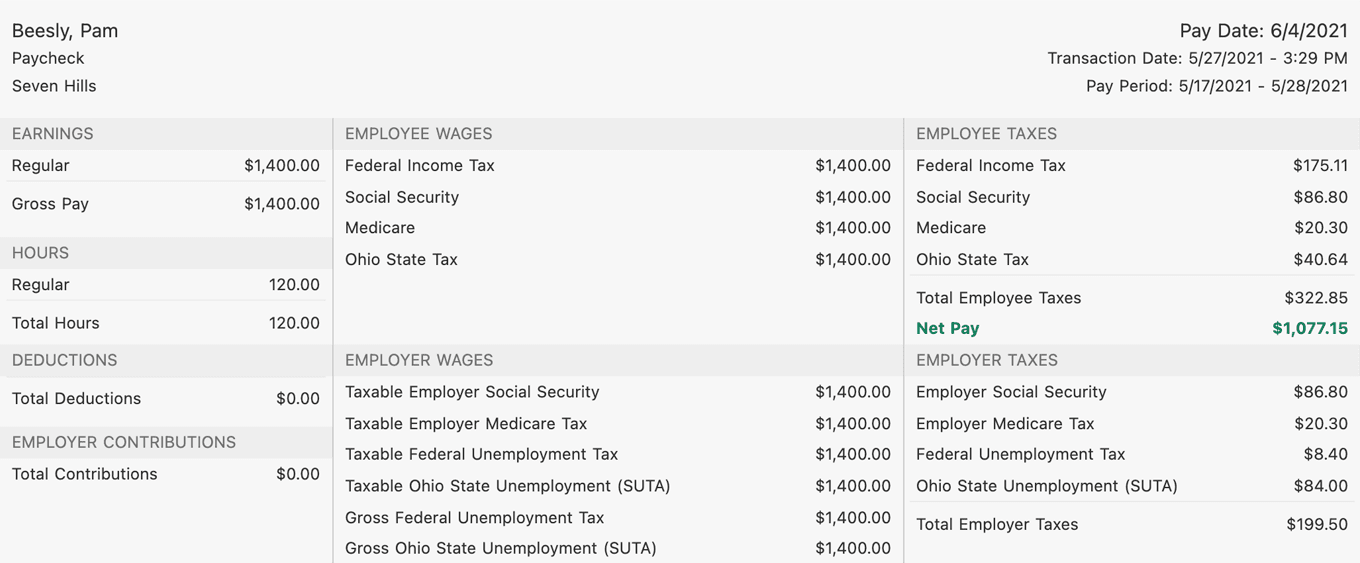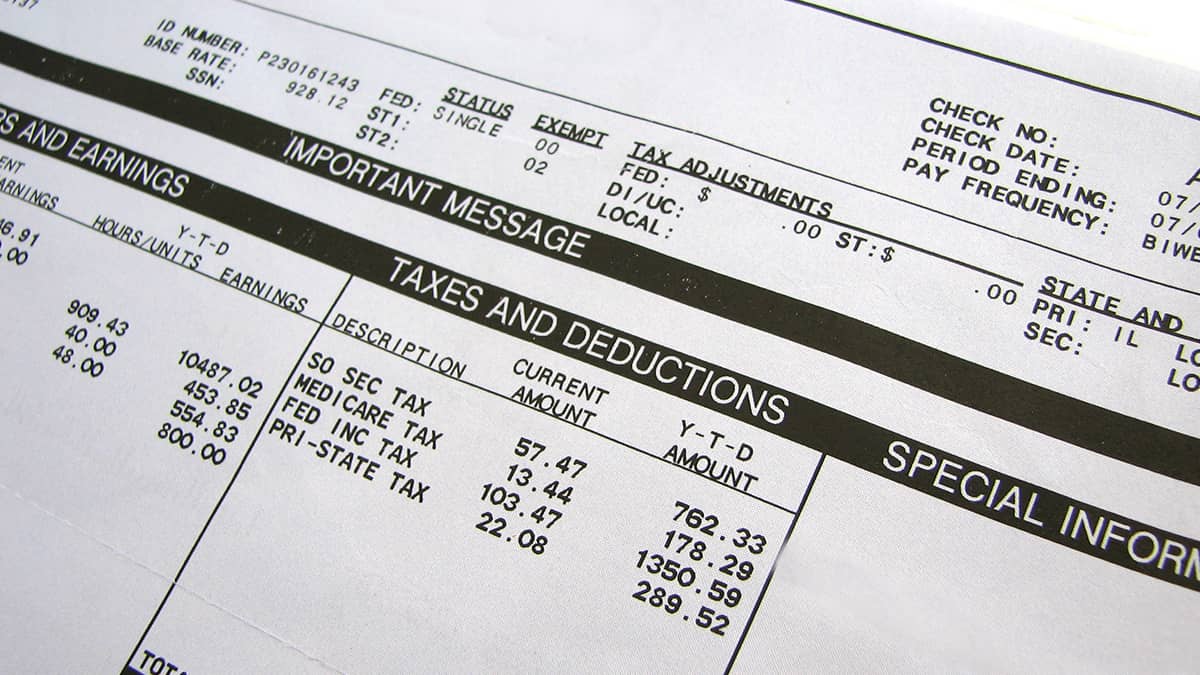When you have employees on payroll, you withhold taxes and issue payments on a regular basis. And regardless of which way you choose to pay your employees (e.g., direct deposit), there is one item you typically need to give to employees: a pay stub. But, what is a pay stub? What is on a pay stub? And, is it really necessary to provide one to your employees?
What is an employee pay stub?
A pay stub, also known as a check stub, is the part of a paycheck or a separate document that lists details about the employee’s pay. It itemizes the wages earned for the pay period and year-to-date payroll information. The check stub also shows taxes and other deductions taken out of an employee’s earnings. And, the pay stub shows the amount the employee actually receives (i.e., net pay). As an employer, you must know how to generate pay stubs for your employees.
What is on a pay stub?
There are many details on a pay stub that help you and your employee keep track of payments, taxes, and deductions. Generally, the items on a pay stub include:
- Gross wages
- Employee taxes
- Deductions
- Employer contributions
- Employer taxes
- Net pay
To understand what information to include in a pay stub, take a look at each category below.
Gross wages
Gross wages are the starting point of your employee’s pay. Gross wages are how much money you owe an employee before you take out any taxes and deductions. If an employee has any nontaxable income, you must also include it under gross wages.
How you calculate the employee’s gross wages depends on if they are hourly or salaried. For hourly workers, multiply the employee’s hourly pay rate by the number of hours worked in the pay period. To find a salaried worker’s gross pay, divide their annual salary by the number of pay periods in the year.
Typically, the pay stub shows gross pay information in two separate columns: current gross pay and year-to-date gross pay
An employee’s gross pay portion of the stub may also include the following information:
Total hours worked: Pay stubs for hourly and nonexempt salary workers must include the number of hours worked. Nonexempt employees can work different types of hours, such as regular, overtime, and double-time. Include the total hours for each type of hour on the check stub. On the pay stub, make sure each kind of hour worked is on its own line. You may also record salaried employees’ hours on their pay stubs, however, it’s not mandatory. Separate the hours worked into current and year-to-date columns.
Pay rate: You should include the employee’s pay rate on their pay stub. For hourly workers, note each employee’s hourly pay rate. If you have a salaried worker, show the salary amount of pay for the pay period worked. Also, record an employee’s separate pay rate(s) on the pay stub for any overtime, double-time, etc. worked.
Employee taxes
Employees do not take home their gross pay amount. Payroll taxes and other deductions (we’ll get to those later) reduce the employee’s earnings. The pay stub itemizes taxes so that employees can see all the tax amounts withheld from their gross pay.
Standard employee payroll taxes on a pay stub include:
- Federal income tax
- The employee portion of FICA tax (Social Security and Medicare taxes)
- State income tax
- Local income tax
- State unemployment tax (for Alaska, New Jersey, and Pennsylvania)
- State- and local-specific taxes
On the pay stub, create a separate line for each tax and show the amount withheld for the current pay period and year-to-date. Separate the employee-paid taxes from the employer-paid taxes on the pay stub.
Deductions
The payroll deductions on a pay stub vary depending on the small business employee benefits you provide. For example, an employee might contribute to insurance premiums or retirement plans.
Deductions could also include charitable contributions, payments toward loans, and any other voluntary or involuntary deductions (e.g., child support). List each deduction on its own line, and show current and year-to-date totals.
Employer contributions
Depending on your business, there may be some line items on an employee’s pay stub that you don’t deduct from the gross pay amount. These generally include amounts you contribute as an employer.
You might contribute to:
- Health insurance premiums
- 401(k) plans
- Health savings accounts (HSA)
- Other retirement plans
List each contribution on its own line with current and year-to-date totals.
Employer taxes
Employers must also pay payroll taxes for each employee. Include these taxes in a separate section with current and year-to-date totals. Employer-paid payroll taxes include:
- Federal unemployment taxes (FUTA tax)
- State unemployment taxes (SUTA tax)
- The employer portion of FICA tax
Check with your state to see if there are any other employer-paid taxes you must pay and include on employee pay stubs.
Net pay
Net pay, or take-home pay, is the amount left over after subtracting taxes and deductions from the employee’s gross pay. If the employee receives nontaxable income, include that income after subtracting all taxes and deductions.
After subtracting taxes and deductions, you have the employee’s take-home pay. The net pay is the total amount you pay the employee.
Include both the pay period net pay and year-to-date net pay on the check stub.
What are pay stubs used for?
A pay stub includes information both employers and employees can use.
Employees receive pay stubs as records of their wages. By reviewing their pay stubs, employees can make sure they were paid correctly and understand their deductions.
Employers can use pay stubs to settle discrepancies with employee pay. If there is a question about an employee’s pay, you might need to solve the issue by looking at the payroll stub. You can also use check stubs to fill out each employee’s Form W-2 during tax time.
Do I have to give pay stubs to my employees?
Some states require employers to provide pay stubs. The information you must include on a paycheck stub can also vary by state.
You can give your employees an electronic (e-paystub) or paper pay stub. If you use payroll software, you may be able to give employees access to their pay stubs online through a portal. Keep a copy of each payroll stub for your employee payroll records.
For more information about pay stub requirements by state, consult your state.
Pay stub example
Phew, now you know what information to include in a pay stub. But, you might be wondering, “What does a pay stub look like?” Check out an example of a pay stub:

Take note of the parts of an employee pay stub:
- Employee name
- Pay period and date
- Hours worked
- Gross pay
- Deductions
- Taxes
- Employer contributions
- Direct deposit information
- Net pay
Understanding check stub information
Understanding information on a pay stub can help solve issues for you and your business. You should know how to create and decipher an employee pay stub.
If an employee quits or is terminated, you might need to pay them quickly. Knowing pay stub information makes the process smoother. The more familiar you are with the parts of a pay stub, the faster you can check for accuracy and pay employees.
Reviewing employee pay stubs can also bring mistakes to your attention. While looking over stubs, check for correct pay rates, hours worked, and total earnings. If an amount seems unusually high or low, you can catch errors early to avoid IRS penalties and conflicts with employees.
| Want to learn more about pay stubs and your responsibilities? Check out our FREE guide, Understand Your Pay Stub Responsibilities. |
Calculating an employee’s net pay should be a simple process. With Patriot’s online payroll software, you can easily enter hours worked, approve payroll, and print pay stubs anywhere, anytime using a simple three-step process. Start your free 30-day trial today!
This article has been updated from its original publication date of August 17, 2015.
This is not intended as legal advice; for more information, please click here.


